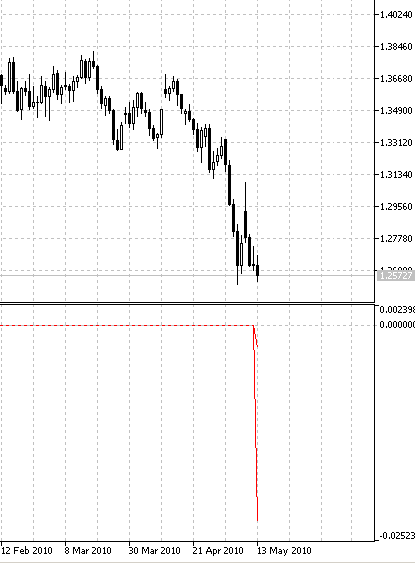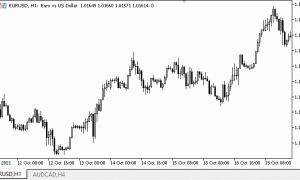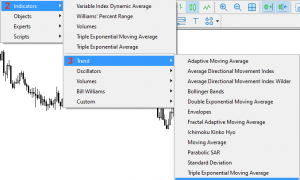简介
亲爱的读者们,你们好!
在今天的文章中,我将向你们介绍一个将简单价格计算从 MQL4 迁移到 MQL5 的算法。在快速查看 MQL5 和 MQL4 之间的差异之后,我添加了函数库 mql4_2_mql5.mqh;在读完本文之后,我们将学会如何使用它。
1. 准备要迁移的指标
本文仅仅围绕指标计算的迁移;如果您一个指标包含图形元素或更加复杂的价格计算,则您会遇到困难。
首先,我们需要准备一个要迁移的 MQL4 代码。让我们看一看为此我们需要什么。
打开 MetaEditor 4 及必要的指标,例如 MACD;开始修改其输入参数:
//---- 指标参数 extern int FastEMA=12; extern int SlowEMA=26; extern int SignalSMA=9; //---- 指标缓存 double MacdBuffer[]; double SignalBuffer[];
我们需要将它们全部置于以下状态:
double &MacdBuffer[],double &SignalBuffer[],int FastEMA,int SlowEMA,int SignalSMA
在代码行的开头指定了指标缓存,并且在它们的名称前面有符号 &。原因在于我们需要传递在其中执行所有变化的数组的链接,而不是数组本身!!!
接着是输入参数。在我们的 MQL4 指标中,将以下代码行:
int start()
改为
int start(int rates_total, int prev_calculated, double &MacdBuffer[], double &SignalBuffer[], int FastEMA, int SlowEMA, int SignalSMA)
如您所见,添加了另外两个必需的元素:
int rates_total, int prev_calculated,
下一部分是我们以前生成的代码行。
现在,将整个部分复制到最后一个交易品种。
//+------------------------------------------------------------------ //| 移动平均的收敛/发散指标(MACD) | //+------------------------------------------------------------------ int start(int rates_total ,int prev_calculated ,double &MacdBuffer[] ,double &SignalBuffer[] ,int FastEMA ,int SlowEMA ,int SignalSMA) { int limit; int counted_bars=IndicatorCounted(); //---- 最近一次计算的柱形将被重算 if(counted_bars>0) counted_bars--; limit=Bars-counted_bars; //---- macd的计算结果在第一个指标缓存中 for(int i=0; i<limit; i++) MacdBuffer[i]=iMA(NULL,0,FastEMA,0,MODE_EMA,PRICE_CLOSE,i) -iMA(NULL,0,SlowEMA,0,MODE_EMA,PRICE_CLOSE,i); //---- 信号线的计算结果在第二个指标缓存中 for(i=0; i<limit; i++) SignalBuffer[i]=iMAOnArray(MacdBuffer,Bars,SignalSMA,0,MODE_SMA,i); //---- 完成 return(0); } //+------------------------------------------------------------------
2. 为 MQL5 程序创建一个 MQL4 模板
现在,我们需要为我们的部分准备环境。
为此,在 MetaEditor 5 中选择菜单项 “New”(新建),然后选择 “Custom indicator”(自定义指标)。
依据 MQL4 指标的输入参数创建输入参数(图 1):
//---- 指标参数 extern int FastEMA=12; extern int SlowEMA=26; extern int SignalSMA=9;

图 1. MACD 指标的输入参数
然后,依据在 MQL4 程序中所写的创建指标缓存(图 2):
//---- 指标缓存 double MacdBuffer[]; double SignalBuffer[];

图 2. MACD 的指标缓存
现在,我们已经为我们的新指标创建了一个模板。
您需要对其进行几处修改。在输入参数上方添加一行:
#include <mql4_2_mql5.mqh> //--- 输入参数
向函数:
int OnInit()
添加以下代码行:
InitMql4();
然后将一行负责针对 MQL4 程序启动环境的代码添加到程序的主体:
int bars=MQL4Run(rates_total,prev_calculated); // bars - MQL4程序可用的柱形数量
如您所见,此函数将返回可用于 MQL4 环境的柱的数量;这里也出现一个新的变量:
int CountedMQL4;
此变量与以下 MQL5 变量类似:
prev_calculated,
CountedMQL4 变量在包含文件中声明;它传递已计算的数据量。
然后,将我们准备好的 MQL4 部分在最后一个交易品种后面插入生成的 MQL5 模板。
现在,我们需要启动指标。
为此,将以下代码行添加到程序的主体:
Start(bars,
CountedMQL4,
MacdBuffer,
SignalBuffer,
FastEMA,
SlowEMA,
SignalSMA);
如您所见,此行将传递对我们的 MQL4 程序而言必不可少的数据,以及到生成的缓存的链接,并且我们将从在 MQL5 中创建的模板获取缓存的名称。
应得到以下结果:
//+------------------------------------------------------------------ //| MACD_MQ4.mq5 | //| Copyright 2010, MetaQuotes Software Corp. | //| http://www.mql5.com | //+------------------------------------------------------------------ #property copyright "Copyright 2010, MetaQuotes Software Corp." #property link "http://www.mql5.com" #property version "1.00" #property indicator_separate_window #property indicator_buffers 2 #property indicator_plots 2 //---绘制 MacdBuffer #property indicator_label1 "MacdBuffer" #property indicator_type1 DRAW_LINE #property indicator_color1 Red #property indicator_style1 STYLE_SOLID #property indicator_width1 1 //--- 绘制 SignalBuffer #property indicator_label2 "SignalBuffer" #property indicator_type2 DRAW_LINE #property indicator_color2 Red #property indicator_style2 STYLE_SOLID #property indicator_width2 1 //--- 输入参数 #include <mql4_2_mql5.mqh> input int FastEMA=12; input int SlowEMA=26; input int SignalSMA=9; //--- 指标缓存 double MacdBuffer[]; double SignalBuffer[]; //+------------------------------------------------------------------ //| 自定义指标初始化函数 | //+------------------------------------------------------------------ int OnInit() { //--- 指标缓存映射 SetIndexBuffer(0,MacdBuffer,INDICATOR_DATA); SetIndexBuffer(1,SignalBuffer,INDICATOR_DATA); //--- InitMql4(); //--- return(0); } //+------------------------------------------------------------------ //| 自定义指标迭代函数 | //+------------------------------------------------------------------ int OnCalculate(const int rates_total, const int prev_calculated, const datetime& time[], const double& open[], const double& high[], const double& low[], const double& close[], const long& tick_volume[], const long& volume[], const int& spread[]) { //--- int bars=MQL4Run(rates_total,prev_calculated); // bars - MQL4程序可用的柱形数量 Start(bars, CountedMQL4, MacdBuffer, SignalBuffer, FastEMA, SlowEMA, SignalSMA);//--- 返回prev_calculated的值用于下一次调用 return(rates_total); } //+------------------------------------------------------------------ //| 移动平均的收敛/发散指标(MACD) | //+------------------------------------------------------------------ int Start(int rates_total, int prev_calculated, double &MacdBuffer[], double &SignalBuffer[], int FastEMA, int SlowEMA, int SignalSMA) { int limit; int counted_bars=IndicatorCounted(); //---- 最近一次计算的柱形将被重算 if(counted_bars>0) counted_bars--; limit=Bars-counted_bars; //---- macd的计算结果在第一个指标缓存中 for(int i=0; i<limit; i++) MacdBuffer[i]=iMA(NULL,0,FastEMA,0,MODE_EMA,PRICE_CLOSE,i) -iMA(NULL,0,SlowEMA,0,MODE_EMA,PRICE_CLOSE,i); //---- 信号线的计算结果在第二个指标缓存中 for(i=0; i<limit; i++) SignalBuffer[i]=iMAOnArray(MacdBuffer,Bars,SignalSMA,0,MODE_SMA,i); //---- 完成 return(0); }
这只是迁移的第一阶段;现在,我们开始调试指标。
3. 在 MQL5 中处理指标缓存的特点
因为很多预定义的 MQL4 变量对应于预定义的 MQL5 变量的名称,您应对迁移的 MQL4 部分进行以下更改:
| MQL4 | MQL5 |
|---|---|
| IndicatorCounted() | prev_calculated |
| Bars | rates_total |
| iMA( | iMAMql4( |
| iMAOnArray( | iMAOnArrayMql4( |
//+--------------------+------------------+ //| MQL4 | MQL5 | //+--------------------+------------------+ //|IndicatorCounted() | prev_calculated | //| Bars | rates_total | //| iMA( | iMAMql4( | //| iMAOnArray( | iMAOnArrayMql4( | //+--------------------+------------------+
无论数据存储组织的特性是什么,MQL5 参考对 SetIndexBuffer() 有以下说明:
备注
在绑定之后,动态数组 buffer[] 将被作为公共数组编制索引,即使为已绑定数组预安装了时间序列的索引。如果您要更改指标数组的存取顺序,在使用 SetIndexBuffer() 函数绑定数组之后使用 ArraySetAsSeries() 函数。
因此,存取指标缓存的初始政策现在与处理普通数组对应,因而您应始终添加绑定:
ArraySetAsSeries(MacdBuffer,true); ArraySetAsSeries(SignalBuffer,true);
结果代码如下所示:
//+------------------------------------------------------------------ //| MACD_MQL4.mq5 | //| Copyright 2010, MetaQuotes Software Corp. | //| http://www.mql5.com | //+------------------------------------------------------------------ #property copyright "Copyright 2010, MetaQuotes Software Corp." #property link "http://www.mql5.com" #property version "1.00" #property indicator_separate_window #property indicator_buffers 2 #property indicator_plots 2 //---绘制 MacdBuffer #property indicator_label1 "MacdBuffer" #property indicator_type1 DRAW_LINE #property indicator_color1 Red #property indicator_style1 STYLE_SOLID #property indicator_width1 1 //--- 绘制 SignalBuffer #property indicator_label2 "SignalBuffer" #property indicator_type2 DRAW_LINE #property indicator_color2 Red #property indicator_style2 STYLE_SOLID #property indicator_width2 1 #include <mql4_2_mql5.mqh> //--- 输入参数 input int FastEMA=12; input int SlowEMA=26; input int SignalSMA=9; //--- 指标缓存 double MacdBuffer[]; double SignalBuffer[]; //+------------------------------------------------------------------ //| 自定义指标初始化函数 | //+------------------------------------------------------------------ int OnInit() { //--- 指标缓存映射 SetIndexBuffer(0,MacdBuffer,INDICATOR_DATA); SetIndexBuffer(1,SignalBuffer,INDICATOR_DATA); //--- InitMql4(); //--- ArraySetAsSeries(MacdBuffer,true); ArraySetAsSeries(SignalBuffer,true); //--- return(0); } //+------------------------------------------------------------------ //| 自定义指标迭代函数 | //+------------------------------------------------------------------ int OnCalculate(const int rates_total, const int prev_calculated, const datetime &time[], const double &open[], const double &high[], const double &low[], const double &close[], const long &tick_volume[], const long &volume[], const int &spread[]) { //--- int bars=MQL4Run(rates_total,prev_calculated); // bars - MQL4程序可用的柱形数量 Start(bars, CountedMQL4, MacdBuffer, SignalBuffer, FastEMA, SlowEMA, SignalSMA); //--- 返回prev_calculated的值用于下一次调用 return(rates_total); } //+------------------------------------------------------------------ //| 移动平均的收敛/发散指标(MACD) | //+------------------------------------------------------------------ //+--------------------+------------------+ //| MQL4 | MQL5 | //+--------------------+------------------+ //|IndicatorCounted() | prev_calculated | //| Bars | rates_total | //| iMA( | iMAMql4( | //| iMAOnArray( | iMAOnArrayMql4( | //+--------------------+------------------+ int Start(int rates_total, int prev_calculated, double &MacdBuffer[], double &SignalBuffer[], int FastEMA, int SlowEMA, int SignalSMA) { int limit; int counted_bars=prev_calculated; //---- 最近一次计算的柱形将被重算 if(counted_bars>0) counted_bars--; limit=rates_total-counted_bars; //---- macd的计算结果在第一个指标缓存中 for(int i=0; i<limit; i++) MacdBuffer[i]=iMAMql4(NULL,0,FastEMA,0,MODE_EMA,PRICE_CLOSE,i) -iMAMql4(NULL,0,SlowEMA,0,MODE_EMA,PRICE_CLOSE,i); //---- 信号线的计算结果在第二个指标缓存中 for(int i=0; i<limit; i++) SignalBuffer[i]=iMAOnArrayMql4(MacdBuffer,rates_total,SignalSMA,0,MODE_SMA,i); //---- 完成 return(0); } //+------------------------------------------------------------------
图 3 显示了执行结果:

图 3. 用 MQL4 重写的 MACD 指标与用 MQL5 写的标准 MACD 指标的比较。
4. 迁移随机动量指标的例子
让我们在 MetaEditor 5 中为我们的指标创建新的模板(图 4-5):

图 4. 输入参数

图 5. 缓存
在调试期间,我们指出应通过简单的复制,将 MQL4 “OnInit” 函数中的几个计算移到 “Start” 函数内:
int draw_begin1=KPeriod+Slowing; int draw_begin2=draw_begin1+DPeriod;
我们还需要更改绘图缓存的数量,因为在我们的 MQL4 程序中使用 2 个缓存来进行内部计算,使用另外 2 个缓存来绘图。
#property indicator_plots 2
并且更改将在我们的 MQL4 程序中用于内部计算的缓存的状态:
SetIndexBuffer(2,HighesBuffer,INDICATOR_CALCULATIONS); SetIndexBuffer(3,LowesBuffer,INDICATOR_CALCULATIONS);
进行必要的更改:
//+------------------------------------------------------------------ //| Stochastic_MQL4.mq5 | //| Copyright 2010, MetaQuotes Software Corp. | //| http://www.mql5.com | //+------------------------------------------------------------------ #property copyright "Copyright 2010, MetaQuotes Software Corp." #property link "http://www.mql5.com" #property version "1.00" #property indicator_separate_window #property indicator_minimum 0 #property indicator_maximum 100 #property indicator_buffers 4 #property indicator_plots 2 //--- 绘制 MainBuffer #property indicator_label1 "MainBuffer" #property indicator_type1 DRAW_LINE #property indicator_color1 Red #property indicator_style1 STYLE_SOLID #property indicator_width1 1 //--- 绘制 SignalBuffer #property indicator_label2 "SignalBuffer" #property indicator_type2 DRAW_LINE #property indicator_color2 Red #property indicator_style2 STYLE_SOLID #property indicator_width2 1 #include <mql4_2_mql5.mqh> //--- 输入参数 input int Kperiod=14; input int Dperiod=5; input int Slowing=5; //--- 指标缓存 double MainBuffer[]; double SignalBuffer[]; double HighesBuffer[]; double LowesBuffer[]; //+------------------------------------------------------------------ //| 自定义指标初始化函数 | //+------------------------------------------------------------------ int OnInit() { //--- 指标缓存映射 SetIndexBuffer(0,MainBuffer,INDICATOR_DATA); SetIndexBuffer(1,SignalBuffer,INDICATOR_DATA); SetIndexBuffer(2,HighesBuffer,INDICATOR_CALCULATIONS); SetIndexBuffer(3,LowesBuffer,INDICATOR_CALCULATIONS); //--- InitMql4(); //--- ArraySetAsSeries(MainBuffer,true); ArraySetAsSeries(SignalBuffer,true); ArraySetAsSeries(HighesBuffer,true); ArraySetAsSeries(LowesBuffer,true); //--- return(0); } //+------------------------------------------------------------------ //| 自定义指标迭代函数 | //+------------------------------------------------------------------ int OnCalculate(const int rates_total, const int prev_calculated, const datetime &time[], const double &open[], const double &high[], const double &low[], const double &close[], const long &tick_volume[], const long &volume[], const int &spread[]) { //--- int bars=MQL4Run(rates_total,prev_calculated); // bars - MQL4程序可用的柱形数量 start(bars, CountedMQL4, MainBuffer, SignalBuffer, HighesBuffer, LowesBuffer, Kperiod, Dperiod, Slowing); //--- 返回prev_calculated的值用于下一次调用 return(rates_total); } //+--------------------+------------------+ //| MQL4 | MQL5 | //+--------------------+------------------+ //|IndicatorCounted() | prev_calculated | //| Bars | rates_total | //| iMA( | iMAMql4( | //| iMAOnArray( | iMAOnArrayMql4( | //+--------------------+------------------+ int start(int rates_total, int prev_calculated, double &MainBuffer[], double &SignalBuffer[], double &HighesBuffer[], double &LowesBuffer[], int KPeriod, int DPeriod, int Slowing) { int draw_begin1=KPeriod+Slowing; int draw_begin2=draw_begin1+DPeriod; int i,k; int counted_bars=prev_calculated; double price; //---- if(rates_total<=draw_begin2) return(0); //---- 用0初始化 if(counted_bars<1) { for(i=1;i<=draw_begin1;i++) MainBuffer[rates_total-i]=0; for(i=1;i<=draw_begin2;i++) SignalBuffer[rates_total-i]=0; } //---- 最少的计数 i=rates_total-KPeriod; if(counted_bars>KPeriod) i=rates_total-counted_bars-1; while(i>=0) { double min=1000000; k=i+KPeriod-1; while(k>=i) { price=Low[k]; if(min>price) min=price; k--; } LowesBuffer[i]=min; i--; } //---- 最大计数 i=rates_total-KPeriod; if(counted_bars>KPeriod) i=rates_total-counted_bars-1; while(i>=0) { double max=-1000000; k=i+KPeriod-1; while(k>=i) { price=High[k]; if(max<price) max=price; k--; } HighesBuffer[i]=max; i--; } //---- %K线 i=rates_total-draw_begin1; if(counted_bars>draw_begin1) i=rates_total-counted_bars-1; while(i>=0) { double sumlow=0.0; double sumhigh=0.0; for(k=(i+Slowing-1);k>=i;k--) { sumlow+=Close[k]-LowesBuffer[k]; sumhigh+=HighesBuffer[k]-LowesBuffer[k]; } if(sumhigh==0.0) MainBuffer[i]=100.0; else MainBuffer[i]=sumlow/sumhigh*100; i--; } //---- 最近一次计算的柱形将被重算 if(counted_bars>0) counted_bars--; int limit=rates_total-counted_bars; //---- 信号线是移动平均 for(i=0; i<limit; i++) SignalBuffer[i]=iMAOnArrayMql4(MainBuffer,rates_total,DPeriod,0,MODE_SMA,i); //---- return(0); } //+------------------------------------------------------------------
结果,我们得到一个用 MQL5 编写的,具有 MQL4 价格结构的完全成熟的随机动量指标。
图 6 显示了其运行结果:

图 6. 用 MQL4 重写的随机动量指标与用 MQL5 写的标准随机动量指标的比较。
5. 迁移 RSI 指标的例子
收集有关我们的指标的信息:
//---- 输入参数 extern int RSIPeriod=14; //---- 缓存 double RSIBuffer[]; double PosBuffer[]; double NegBuffer[];
并且在 MetaEditor 5 中为其创建一个模板(图 7-8)。

图 7. RSI 指标的输入参数

图 8. RSI 指标的缓存
缓存总数为 3:
#property indicator_buffers 3
用于绘图的缓存数量为 1:
#property indicator_plots 1
设定用于计算的缓存的状态:
SetIndexBuffer(1,PosBuffer,INDICATOR_CALCULATIONS); SetIndexBuffer(2,NegBuffer,INDICATOR_CALCULATIONS)
安排各个部分并进行必要的更改:
//+------------------------------------------------------------------ //| RSI_MQL4.mq5 | //| Copyright 2010, MetaQuotes Software Corp. | //| http://www.mql5.com | //+------------------------------------------------------------------ #property copyright "Copyright 2010, MetaQuotes Software Corp." #property link "http://www.mql5.com" #property version "1.00" #property indicator_separate_window #property indicator_buffers 3 #property indicator_plots 1 //--- 绘制 RSIBuffer #property indicator_label1 "RSIBuffer" #property indicator_type1 DRAW_LINE #property indicator_color1 Green #property indicator_style1 STYLE_SOLID #property indicator_width1 1 //--- 绘制 PosBuffer #property indicator_label2 "PosBuffer" #property indicator_type2 DRAW_LINE #property indicator_color2 Red #property indicator_style2 STYLE_SOLID #property indicator_width2 1 //--- 绘制 NegBuffer #property indicator_label3 "NegBuffer" #property indicator_type3 DRAW_LINE #property indicator_color3 Red #property indicator_style3 STYLE_SOLID #property indicator_width3 1 #include <mql4_2_mql5.mqh> //--- 输入参数 input int RSIPeriod=14; //--- 指标缓存 double RSIBuffer[]; double PosBuffer[]; double NegBuffer[]; //+------------------------------------------------------------------ //| 自定义指标初始化函数 | //+------------------------------------------------------------------ int OnInit() { //--- 指标缓存映射 SetIndexBuffer(0,RSIBuffer,INDICATOR_DATA); SetIndexBuffer(1,PosBuffer,INDICATOR_CALCULATIONS); SetIndexBuffer(2,NegBuffer,INDICATOR_CALCULATIONS); //--- InitMql4(3); ArraySetAsSeries(RSIBuffer,true); ArraySetAsSeries(PosBuffer,true); ArraySetAsSeries(NegBuffer,true); return(0); } //+------------------------------------------------------------------ //| 自定义指标迭代函数 | //+------------------------------------------------------------------ int OnCalculate(const int rates_total, const int prev_calculated, const datetime &time[], const double &open[], const double &high[], const double &low[], const double &close[], const long &tick_volume[], const long &volume[], const int &spread[]) { int bars=MQL4Run(rates_total,prev_calculated); // bars - MQL4程序可用的柱形数量 RSImql4(bars, CountedMQL4, RSIBuffer, PosBuffer, NegBuffer, RSIPeriod); return(rates_total); } //+--------------------+------------------+ //| MQL4 | MQL5 | //+--------------------+------------------+ //|IndicatorCounted() | prev_calculated | //| Bars | rates_total | //| iMA( | iMAMql4( | //| iMAOnArray( | iMAOnArrayMql4( | //+--------------------+------------------+ int RSImql4(int rates_total, int prev_calculated, double &RSIBuffer[], double &PosBuffer[], double &NegBuffer[], int RSIPeriod) { int i,counted_bars=prev_calculated; double rel,negative,positive; //----fd if(rates_total<=RSIPeriod) return(0); //---- 用0初始化 if(counted_bars<1) for(i=1;i<=RSIPeriod;i++) RSIBuffer[rates_total-i]=0.0; //---- i=rates_total-RSIPeriod-1; if(counted_bars>=RSIPeriod) i=rates_total-counted_bars-1; while(i>=0) { double sumn=0.0,sump=0.0; if(i==rates_total-RSIPeriod-1) { int k=rates_total-2; //---- 初始累加 while(k>=i) { rel=Close[k]-Close[k+1]; if(rel>0) sump+=rel; else sumn-=rel; k--; } positive=sump/RSIPeriod; negative=sumn/RSIPeriod; } else { //---- 平滑移动平均 rel=Close[i]-Close[i+1]; if(rel>0) sump=rel; else sumn=-rel; positive=(PosBuffer[i+1]*(RSIPeriod-1)+sump)/RSIPeriod; negative=(NegBuffer[i+1]*(RSIPeriod-1)+sumn)/RSIPeriod; } PosBuffer[i]=positive; NegBuffer[i]=negative; if(negative==0.0) RSIBuffer[i]=0.0; else RSIBuffer[i]=100.0-100.0/(1+positive/negative); i--; } //---- return(0); } //+------------------------------------------------------------------
在这里,与前一个指标不同,我们更改名称:现在,代替在 MQL4 中有用的 int Start() 函数
int start()
{
我们在 MQL5 中使用
int RSImql4(
函数本身的名称以及在 MQL5 中的调用位置都出现改变。
图 9 显示了库的运行结果。

图 9. 用 MQL4 重写的 RSIc 指标与用 MQL5 写的标准 RSI 指标的比较。
6. 设置
要设置此模块,您需要将 mql4_2_mql5.mqh 文件复制到 MQL5/Include/ 文件夹。
测试文件应放于 MQL5/Indicators 文件夹中。
7. 改进
如果您愿意,您可以通过依据“从 MQL4 迁移到 MQL5”一文,连接一个库来扩展模块的功能。将 InitMQL4.mqh 文件添加到 MQL5/Include 文件夹,并且在输入参数之前添加以下代码行:
#include <InitMQL4.mqh>
您可以在“从 MQL4 迁移到 MQL5”一文中熟悉必要的更改。
总结
本文介绍了使用特殊的 mql4_2_mql5.mqh 库将简单价格结构从 MQL4 迁移到 MQL5 的算法。
在调试期间您可能会遇到一些麻烦,但是对于熟悉 MQL4 的人而言,复制它们并不会成为一个问题。
考虑到在 MQL5 环境中存取数据的特性,指标的重新计算可能要用一些时间。原因在于我们必须针对来自 MQL4 环境的程序创建和重新计算必要的数据。对于到 MQL5 环境的完全成熟的指标迁移,在重写时应考虑到在 MQL5 中存储和存取数据的特性。
附注
我想提醒您注意“考虑到在 MQL5 环境中存取数据的特性,指标的重新计算可能要用一些时间。原因在于我们必须针对来自 MQL4 环境的程序创建和重新计算必要的数据。”这两句。有时等待可能会持续几秒钟(见图 10-11):


图 10. 未计算出数据 图 11. 有数据可用
这与客户端的一个特点有关 – 在创建指标句柄时,在客户端的高速缓存中只创建计算部分的一个副本。如果尚未创建此类指标(具有相同的输入参数),则
iMA(Symb,TimFram,iMAPeriod,ma_shift,ma_method,applied_price);
函数的调用将创建一个移动平均线指标,但是仅创建一次。
下一次尝试创建已经存在的指标时,客户端将仅返回其句柄。
因此,指标的计算仅执行一次,而不是刚刚在创建其句柄之后。
本文译自 MetaQuotes Software Corp. 撰写的俄文原文
原文地址: https://www.mql5.com/ru/articles/66
(7.83 KB)
(32.21 KB)
(9.27 KB)
(10.61 KB)
MyFxtop迈投-靠谱的外汇跟单社区,免费跟随高手做交易!
免责声明:本文系转载自网络,如有侵犯,请联系我们立即删除,另:本文仅代表作者个人观点,与迈投财经无关。其原创性以及文中陈述文字和内容未经本站证实,对本文以及其中全部或者部分内容、文字的真实性、完整性、及时性本站不作任何保证或承诺,请读者仅作参考,并请自行核实相关内容。
著作权归作者所有。
商业转载请联系作者获得授权,非商业转载请注明出处。








